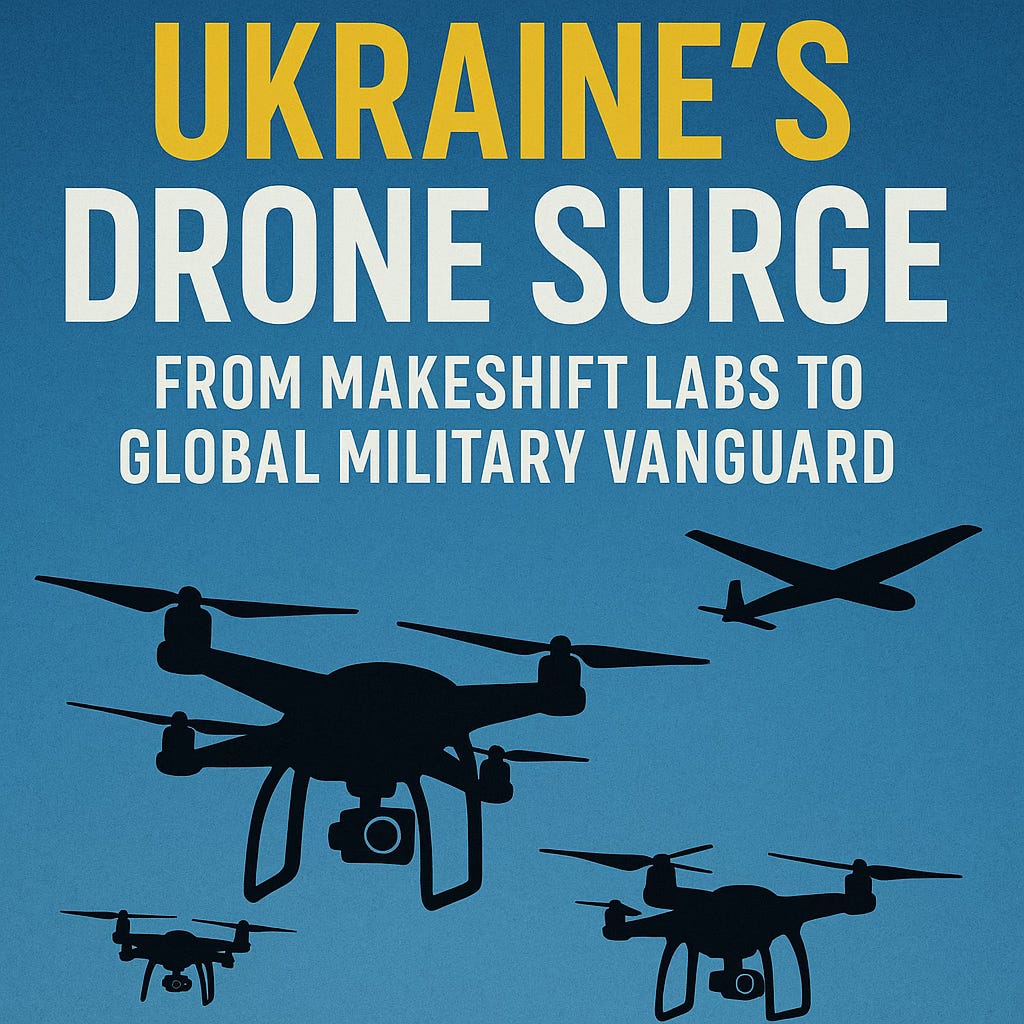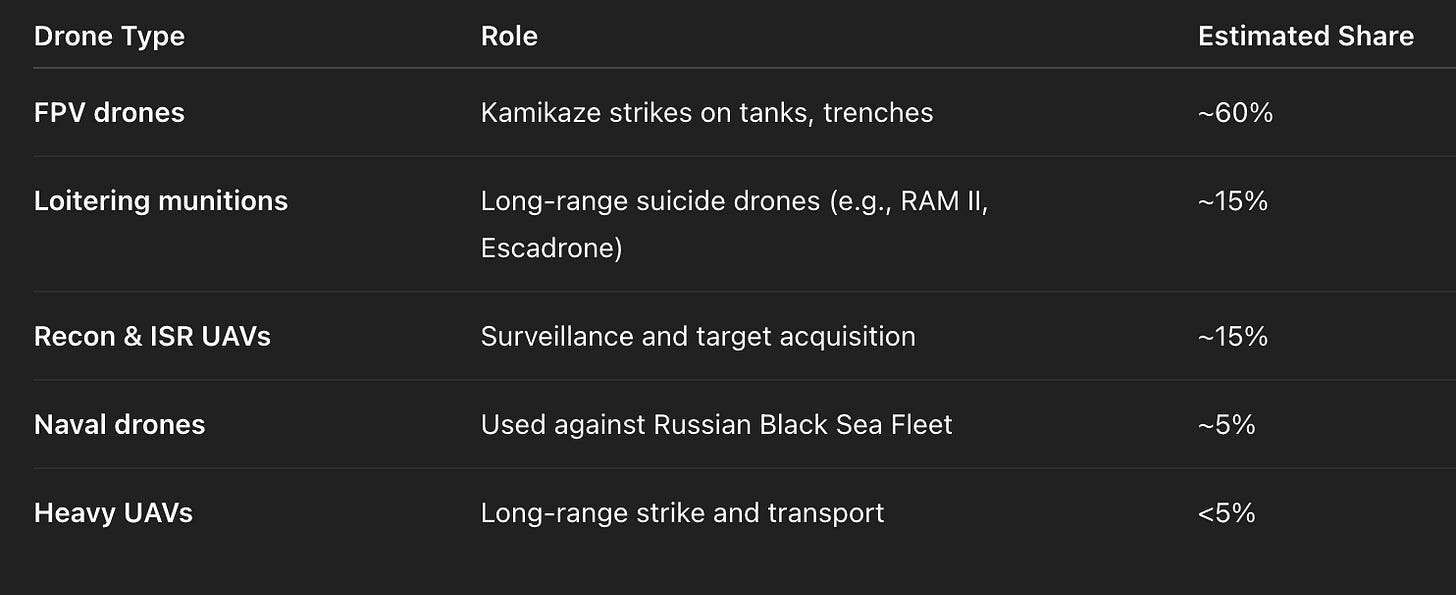Ukraine 3 million Drones produced a Year!
By Rafael Benavente
🇺🇦
Ukraine’s Drone Surge: From Makeshift Labs to Global Military Vanguard
How Ukraine Went from Buying Drones to Producing Millions a Year—and What It Means for the Future of Warfare
In the early months of Russia’s 2022 invasion, Ukraine scrambled to source drones from wherever it could—off-the-shelf DJI quadcopters, modified FPVs, and even commercial hobby kits. Fast forward to 2025, and Ukraine has emerged as one of the largest drone producers on Earth, manufacturing millions annually, surpassing most Western nations in scale, speed, and battlefield innovation.
⚙️ The Numbers: From Hundreds to Millions
Just two years ago, Ukraine’s drone industry was a patchwork of volunteer groups and tech startups. Today, it is a national priority, with direct state investment, military procurement contracts, and regulatory reforms fast-tracking development.
Production Highlights:
2024 output: ~2.2 million drones
2025 projection: 2.5–3 million units
Peak capacity (per Defense Ministry): Up to 10 million drones/year
Monthly output as of mid-2025: ~200,000 drones
This meteoric rise reflects a strategic choice: saturate the frontlines with disposable, effective, low-cost uncrewed systems rather than relying solely on large, expensive hardware.
🧠 How Ukraine Did It: A Decentralized Tech Ecosystem
Rather than centralizing production in a few mega-factories, Ukraine has adopted a networked manufacturing model, activating hundreds of:
Tech startups
Volunteer workshops
University R&D labs
Private defense companies
This agility allows for:
Rapid iteration (some models go from prototype to front line in weeks)
Localized sourcing of parts
Redundancy—if one facility is hit, others pick up production
Much of this is coordinated under programs like "Army of Drones" and platforms like Brave1, which streamline funding, testing, and integration.
🚁 What Types of Drones Are Being Built?
Ukraine’s drone production covers a vast spectrum, including:
The FPV drone has become the workhorse—cheap ($300–$800), agile, and deadly. Ukraine now field-tests and modifies FPVs for anti-tank, anti-personnel, and even EW-hardened variants.
🧨 The Battlefield Impact
The effect on Russia’s military is profound:
Tank columns stalled or destroyed by FPVs before contact with Ukrainian forces
Artillery units forced to reposition frequently due to constant drone overwatch
Ships hit in port, leading to partial withdrawal of the Black Sea Fleet
Infantry units dug in, knowing they’re watched or targeted 24/7
Even more powerful than the drones themselves is the tactical doctrine Ukraine has developed—a “drone-first” battlefield philosophy that merges real-time targeting, AI-assisted recon, and rapid kill chains.
🏗️ Domestic vs. Foreign Sourcing
While Ukraine began by importing drones (notably from Turkey, U.S., and Taiwan), 2025 marks a tipping point:
Over 90% of drones now made domestically
Ukrainian-developed AI, EW shielding, and flight control software
Additive manufacturing and carbon-fiber printing for fast parts turnaround
Key Ukrainian drone innovators include:
Escadrone – loitering munitions
Skyeton – surveillance UAVs
Ukrspecsystems – high-end fixed-wing systems
Victory Drones, Kvertus, and dozens more small-scale producers
📉 Cost vs. Impact: Why Drones Win
One of the key strengths of Ukraine’s drone model is asymmetry.
MetricTraditional SystemUkrainian DroneUnit cost$5M–$15M (tank, jet)$300–$3,000LogisticsComplex, heavyLight, distributedAttritionCatastrophicAcceptable/expectedKill ratio1:1 or 1:2Often 1:5 or better
Drones invert the cost-benefit equation: Ukraine can disable or destroy $5 million systems with a $500 FPV flown by a soldier using off-the-shelf VR goggles and Starlink connectivity.
🛰️ What’s Next: AI, Autonomy, and Mass Deployment
Ukraine’s defense planners are looking toward:
AI-enabled autonomous swarming
Machine learning for flight optimization
EW-hardened drones with anti-jam navigation
Long-range naval drones with stealth capabilities
Drone-on-drone dogfights
The Ministry of Digital Transformation has confirmed work on autonomous recon and strike drones with no human pilot, using pre-defined mission zones and target profiles.
🇺🇸 Lessons for the West—and the World
The U.S., U.K., and NATO allies have taken notice. Western military doctrine is being rewritten to accommodate what Ukraine has demonstrated: drones can win wars—not just support them.
But there’s a caveat: Ukraine’s ability to scale to 4–10 million drones annually still depends on:
Consistent Western funding
Supply chains for lithium batteries, carbon fiber, and electronics
Security for facilities under constant threat from Russian missile strikes
🧾 Final Thoughts
Ukraine’s drone revolution is not just a war story—it’s a case study in 21st-century innovation under fire. By empowering a decentralized network of makers, adapting battlefield feedback in real time, and maximizing asymmetric tactics, Ukraine has shown the world how modern wars might be fought—and won.
From DIY labs to the frontlines of a superpower conflict, Ukraine now leads the world in drone warfare.🌍 Ukraine vs Global Drone Production (2025)
🟦 Ukraine’s Output
2024: ~2.2 million drones produced Prism UA+12TS2 Space+12New York Post+12Finway+10Forbes+10Business Insider+10
2025 forecast: 2.5–3 million actual, with a capacity ceiling around 4–4.5 million per year TS2 SpaceForbesFinway
Ukraine now hosts ≈500 drone manufacturers, up from just a handful pre‑2022 Wall Street Journal+15Georgetown Security Studies Review+15Bloomberg.com+15
🌐 Global Context
Total global military drone expenditure (all countries) in 2024 was valued at $40–41 billion Grand View Research+1Prism UA+1
Ukraine alone is producing more drones yearly than most national militaries combined—including high-end UAVs like MALE, HALE, & UCAV models built by the U.S., China, Israel, Turkey The Business Research Company.
🇷🇺 Russia & China
Russia is aiming for ~1.4 million drones in 2025 MarkNtel Advisors+6Bloomberg.com+6Forbes+6
China leads overall in drone production (commercial + military), but Ukraine claims to be the world’s largest military drone producer New York Post+7The Washington Post+7The Business Research Company+7
📊 Summary Table
Country/RegionEstimated Annual Drone ProductionNotesUkraine2.5–3M (capacity ~4–4.5M)Military/combat-focused, mass-deployedRussia~1.4MFollowing Ukraine's lead, aided by ChinaChina / Turkey et al.Millions (commercial + military)China leads in volume; Ukraine leads in military categoryU.S. & Allies~100k–200k military-onlyEmphasis on high-end, few strategic UAVs The New YorkerCouncil on Foreign Relations+3New America+3The Week+3The Times
🚀 Why Ukraine Leads in Military Drones
Volume over sophistication: Ukraine emphasizes disposable, low-cost FPVs (~$300–800 each) and loitering munitions—produced in huge volumes Bloomberg.com+6TS2 Space+6New York Post+6
Supported by state-backed R&D funding, fast track procurement, and a decentralized base of ~500 manufacturersGeorgetown Security Studies Reviewcsis.org
Contrasts sharply with U.S. and NATO, which focus on fewer, expensive systems like Reaper, MQ-9, and strategic long-endurance drones Wall Street JournalCNAS
✅ Bottom Line
Ukraine currently manufactures more combat drones annually than any other country. Its output of 2.5–3 million in 2025, with capacity up to 4–4.5 million, dwarfs both Russia (~1.4M) and Western programs (~0.1M). While countries like China and Turkey may produce drones in high volumes overall, Ukraine leads the world in military-grade, front‑line drone production.
Note – July 2025: Recent updates have been made to offer insight into case references involving Rafael Benavente found in public databases. As many of these entries appear without background or resolution, this blog offers a more complete perspective.
By Rafael Benavente


